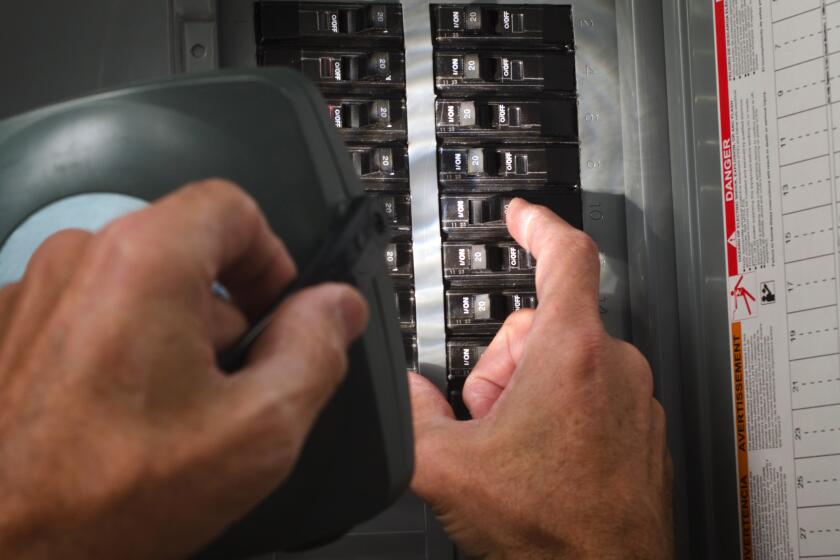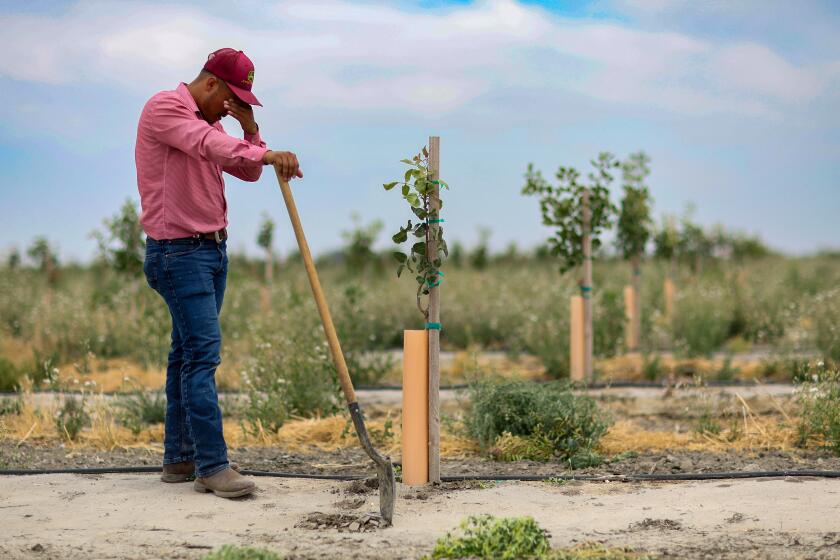Large Trees Are at Root of Many Sewer Problems
As Bob Kinski took a shower one fateful morning last summer, he felt the water gather around his ankles and made a mental note to pick up some drain cleaner when he went to the store later. He continued to shower in his tub, then suddenly realized that the water level was moving up to his shins.
“It occurred to me that this was some stoppage and maybe I should get the plunger,” he recalled. “Then when I looked down and saw that the tub was filling up with black, cold, stinky water, I knew I’d better get a plumber out here.”
All the drains and toilets in Kinski’s West Los Angeles house had backed up, and the culprit was the beautiful cut-leaf maple tree in his front yard.
“The roots had just broken into the sewer line and blocked the flow,” he said. “There was no place for sewage to go but right back up the drain.”
Kinski’s experience is all too common in Southern California, where big trees are often the featured part of the frontyard’s landscaping.
To a hungry tree’s roots, an old sewer line is a rich source of water and nutrients. A small leak is all that’s needed to start the headaches.
“In homes where clay pipe has been used for the sewer line, the fittings are cemented, and they break down over time,” said Scott Blanke of Central Plumbing & Heating Supply in La Habra. “The roots get into the fitting and pipe and eventually they block it.”
Sewer lines are not something most homeowners think about, unless that moment comes when toilets don’t flush and sinks spill over.
Generally buried about three to four feet, the four-inch-diameter sewer line runs from the house to the main sewer line under the street, descending one-quarter inch per foot. Considering the problems created by tree roots, it’s a wonder that they’re planted over the sewer line so frequently.
“When a tree is planted it’s small, and it’s hard to imagine it’s going to cause any problems,” said Bobby Williams of Williams Brothers Plumbing in Newberry Park. “And when the house is fairly new, the dirt above the sewer line is pretty soft and easy to dig, so that’s a logical place to plant something.”
Usually, the roots attack the pipe from the top. As they pry the pipe open, sewage leaks into the ground, attracting more roots, and the problem gets worse.
However, if a sewer line backup occurs, don’t automatically think the problem is invading tree roots.
“Earth settlement, earthquakes--these can affect the flow in the drains,” Blanke said. “You can get a flat spot in the line where the water just collects and pools. Often the cause is something that got stuck before it reached the sewer line, like a child’s toy or hygiene products.”
“Remember that the fall of one-quarter inch every foot isn’t very much,” said Buddy Dingman of Familian Pipe & Supply in West Los Angeles. “When you have a lot of water going through the pipe, it’s just fine. But in this era of low-flow toilets in which you’re not using as much water to get solids down to the main sewer line, you can run into problems.”
Dingman also points out that as sewer pipes age, they can develop a fungus that grows inside the lining. “Instead of being smooth, the pipe is ‘sticky,’ and blockages can collect until you have a problem,” he said.
Until fairly recently, a plumber’s diagnosis of what’s causing a clog was based on his skill with an auger and guesswork. Now, many plumbers have miniature video cameras that allow them to see the line blockage.
“The camera is attached to a cable, and it gives you a color picture of what’s happening down there,” Blanke said. “It’s perfect for finding the exact cause and location of the problem. It cuts down on the hunting time.”
Getting a camera’s view of your sewer line isn’t cheap. Expect to pay $300 to $500 for a sight you’ll likely want to forget. “It’s helpful when someone can’t believe that there are roots or some obstruction down there. You film it, pop the video tape into their VCR and they can see for themselves,” Blanke said.
If the line is blocked by an object, the plumber can use an auger or “snake” to try to push it through the line, which can cost $100 and up.
Another option is high-pressure “jetting,” which involves forcing water at up to 1,800 pounds per square inch through the line. Jetting, which generally costs $150 to $200, is often used in commercial applications. “In restaurants to get rid of grease, that sort of thing,” Blanke said. “It’s also strong enough to tear away roots and really shines up the inside of the pipe.”
When root invasion is the problem, the easiest fix, though temporary, is to cut a path through the obstruction with a cutting auger. Costing anywhere from $50 to $500, this method of clearing out the roots can bring immediate relief. The blades shred the roots, but they don’t cut them cleanly. Often, the roots come back with a vengeance and clog the line faster than before.
This is also an area in which homeowners need to be on guard. “There are lots of people out there with a few pieces of equipment trying to make a fast buck clearing sewer lines,” Blanke said. “If you don’t know what they’re doing, you can really get taken.”
One workman might charge $4 per foot of auger needed to clear the drain but accesses the line from the farthest point in the house or through a vent pipe on the roof, which could mean that $80 is spent before his auger reaches the clog.
Another might charge a flat rate of about $50 per clog, but if the job takes extra work to clear, they may do just enough to get the water flowing for a little while before the roots overtake it again.
Although the best advice on what to do when roots invade is to replace the line, it’s not always something that needs to be done right away or even at all. There are cases when roots are kept in check with drain poisons and an annual cleaning of the line.
In a worst-case scenario, you may have to have the line cleared out once a month. Root poison in your drains can slow down the growth but won’t solve the problem.
“Poisons can kill the roots, but water flows pretty regularly through the line and so it’s diluted and isn’t in contact with the growth very long,” Williams said.
Effective root clearing is also determined by the design of your system. While the sewer line is four inches in diameter, the clean-outs, or access lines to get to the main line are often two inches.
“What happens is that you can only get a two-inch cutting head into the line, so you’re not getting a complete job and you’re having to get it cleaned out even sooner,” Blanke said. “In that case you’re better off having a four-inch clean-out installed so that at least you’re getting the drain as clean as possible.”
For those whose homes were built from the mid-1960s to mid-1970s, sewer line clogs might require an immediate replacement. During this period, many builders used a sewer pipe that was basically made of cardboard coated with tar. “It worked for a while, then it just deteriorated like a wet paper bag,” Dingman said. “I think most of them have already been replaced.”
Sewer line replacement is the final solution for a root invasion or an entrenched clog. The material cost for replacing the line is around $100, but because of the labor involved, the total usually reaches $1,500 to $2,000.
“It can get expensive if there’s a driveway or sidewalk you have to get through then you have to add in the costs of replacing any landscaping,” Williams said. In some cases, the offending tree can be saved. Otherwise, you’ll have to deal with disposing of the tree as well.
On properties where a driveway curves around the front of the house, it may be necessary to cut through the driveway to reach the line underneath. “That’s not preferable of course, since the repaired driveway isn’t going to look as nice,” Blanke said. “In some cases, though, you can dig underneath the pipe and get to it without tearing up the driveway.”
ABS pipe, which is made of a tough plastic, is generally used to replace the old clay or tar paper lines. “It’s strong but it has some flex to it, which keeps it from being susceptible to cracking,” Blanke said.
In rare cases, root damage can occur to the six-inch clay pipe that connects the house line with the municipal line beneath the street. And in most cities, the homeowner is responsible for this line. When this happens, expenses escalate. “When the street has to be dug up, you’re looking at at least $3,500,” Williams said. “Fortunately, that doesn’t happen very often.”
More to Read
Sign up for Essential California
The most important California stories and recommendations in your inbox every morning.
You may occasionally receive promotional content from the Los Angeles Times.






